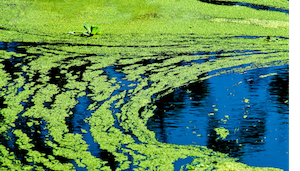 As if the heat weren't enough to worry about in the summer, now add Harmful Algal Bloom (HAB) in streams and lakes where your dogs cool off to the list of worries.
As if the heat weren't enough to worry about in the summer, now add Harmful Algal Bloom (HAB) in streams and lakes where your dogs cool off to the list of worries.
If your dog likes to jump in a pool of water, don't let them if you see blue-green algae. It can poison them. It can kill them.
If you already did let them hop in a pond and you're not sure if blue-green algae was in it, here are the signs and symptoms that they have ingested some: Diarrhea or vomiting, drooling, blood in stool, pale mucous membranes, jaundice, weakness, disorientation or confusion, collapsing or unconsciousness, seizures, and breathing difficulties.
Blue-green algae, or cyanobacteria, can be found in fresh water or salt water estuaries and it can contain toxins that can be fatal to dogs within minutes, hours, or days of exposure. So, it's just best to avoid altogether. That is also true for you, but dogs are more likely than people to ingest it when swimming.
Unlike green algae, blue-green algae can be fatal. Blue-green algae is on the rise due to factors like the use of crop fertilizer and rising temperatures due to climate change. Cyanobacteria can vary in color. Aside from the familiar blue-green, harmful blooms may be blue, bright green, brown or red. They may resemble paint floating on the surface.
The heat is also a good reminder to make sure your pets are never left in cars, or confined spaces where heat can rise dramatically and fast. Aside from these two don'ts, the dos include: do provide shade, do hydrate a little extra and definitely do get out there and have fun this summer.


